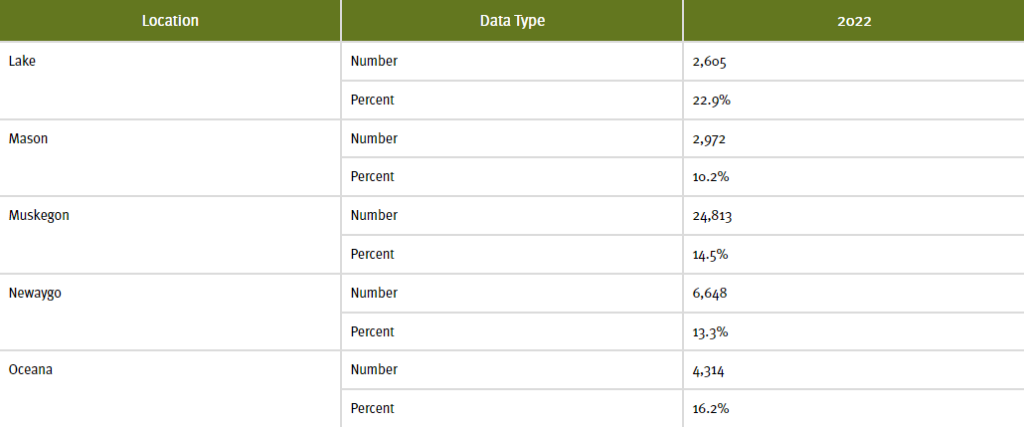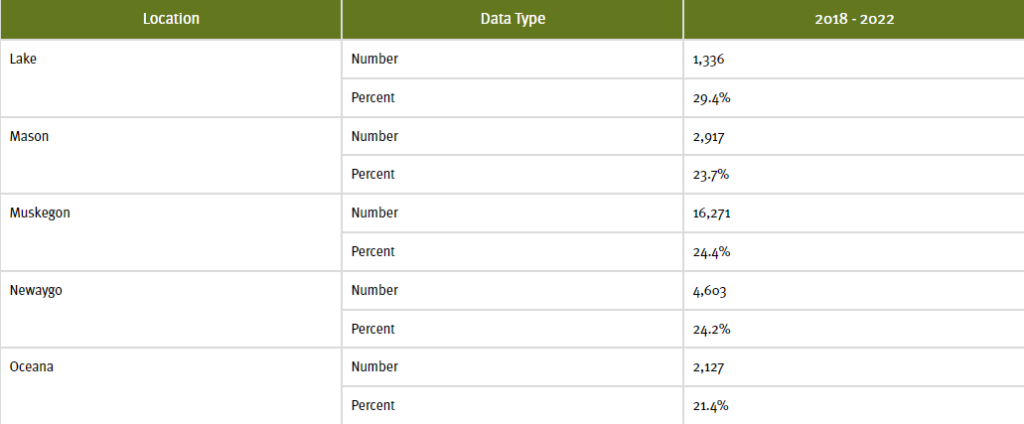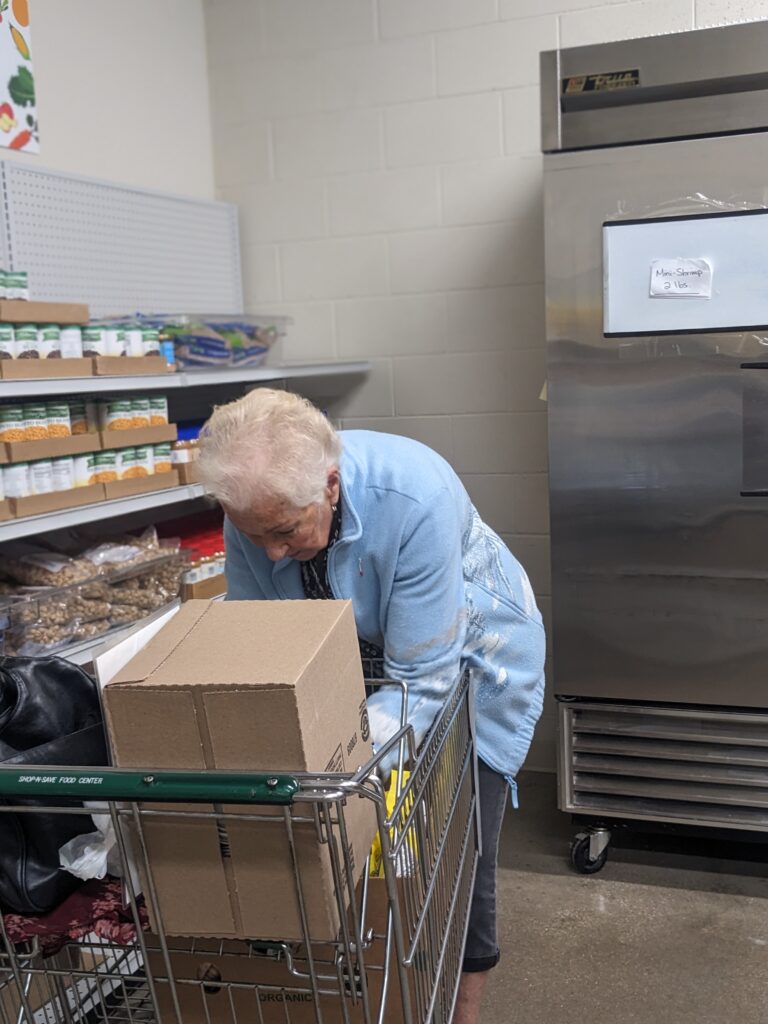Realities of Food Insecurity in Rural West Michigan
Realities of Food Insecurity in Rural West Michigan
Unfortunately in rural Michigan, there is a high percentage of families and individuals who experience food insecurity. But, what does that look like? Food insecurity has many facets–making it challenging to paint a clear picture of what individuals experience because it rarely is an isolated issue.
The complexity of the issue doesn’t mean we can’t discuss the realities of food insecurity in rural West Michigan. This is just a reminder that food insecurity looks different for those who experience it. But, there are still common factors and repercussions that are important to understand in the fight to end food insecurity and hunger in West Michigan communities.
Keep reading to learn more about the realities of food insecurity and how you can step in and make a difference.
Difference between Food Insecurity and Hunger
In order to look at the realities of food insecurity in West Michigan, we need to define what it means to be food secure, be food insecure and experience hunger. Many use food insecurity and hunger interchangeably, but there are real differences between the two terms.
According to the Economic Research Service of the U.S. Department of Agriculture (USDA ERS), a food secure household means that every member in that household has continual access to enough food for a healthy lifestyle.
A food insecure household would not have dependable access to the nutritious food necessary to lead a healthy life. They also may need to resort to emergency measures to have enough to eat.
So, food insecurity is related to not having quality food access whereas hunger is the poor physical effect resulting from a lack of food.
Causes of Food Insecurity in Rural West Michigan
While every individual who experiences food insecurity has their own story, there are a few common contributing factors.
Poverty and the cost of living are two of the largest causes of food insecurity and hunger. These two issues have a number of contributing factors from lack of affordable housing and unemployment to unforeseen emergencies and health concerns. Unfortunately, sometimes all it can take is an unplanned major expense such as needing to replace a car, unexpected surgery or a parent losing a job that can lead to a household becoming food insecure.
Below is a snapshot of the number of West Michigan residents that experience a few of these factors. For the purposes of this article, we are looking at the following counties that TrueNorth serves: Lake, Mason, Muskegon, Newaygo and Oceana. This is just a portion of West Michigan and is not representative of its entirety. The data and charts were gathered by Kids Count Data Center, funded by the Annie E. Casey Foundation:
2022 Poverty of All Ages: Measured in People

2022 Families with High-Housing Cost Burden: Measured in Households

2023 Unemployment: Measured in the Average Annual Number of Unemployed Workers

ALICE Households (Asset limited, income constrained, employed): Measured in People who are in Qualifying Households

Transportation is another barrier to food security. Most rural communities do not have public transportation. While urban cities are more walkable and have public transportation, those who live in rural areas can live miles away from the nearest grocery store. So if someone loses access to a car or cannot afford one, it can be extremely challenging for them to access the nutritional food they need.
There are a number of ways individuals and families can become food insecure. Looking at these causes creates a better understanding of what individuals and families experience and how this impacts their lives.
Impacts of Food Insecurity
Food insecure individuals face a number of poor effects from not having access to nutritious food. Poor health is one of the biggest consequences. Feeding America describes how food insecurity can negatively impact both physical and mental health.
Physical health is one of the most observable effects of hunger. Malnutrition and chronic conditions such as heart disease and diabetes are more likely to occur for people who lack food security, as Feeding America describes. Not having healthy, nutritious food to eat also hinders development in children and can lead to unhealthy relationships to food later in life.
Mental health is also negatively impacted. Not knowing where your next meal is coming from increases stress and anxiety, even leading to depression. This can lead to eating disorders and unhealthy relationships with food as well.
Overall, food insecurity leads to instability for those who experience it. Having to decide between buying food, paying rent or other needed expenses should not be a decision people have to make.
Who is Affected
Food insecurity can affect anyone. From individuals and families to seniors, all it takes is one financial or emergency setback to become food insecure. Rural communities like those in West Michigan face unique challenges to those in urban areas. Between lack of transportation, high poverty rates and limited access to nutritional food overall, many individuals and families struggle to put food on their tables.
According to Feeding America’s “A Report on County and Congressional District Food Insecurity and County,” the average percentage of food insecure individuals across all counties and districts in the United States was around 13% in 2022. Looking at the selected rural communities in West Michigan specifically, there is a definite increase of food insecure individuals from the national average. We highlighted these counties because they are a part of TrueNorth’s service areas. Below are a few of the percentages of food insecure individuals by county from Feeding America’s Map the Meal Gap calculator:
- Lake County: 19.8%
- Mason County: 15.9%
- Muskegon County: 14.1%
- Newaygo County: 16.2%
- Oceana County: 16.4%
This is just a brief snapshot of those who experience food insecurity in our communities. But, these numbers don’t illustrate how not having enough to eat actually affects individuals in their day-to-day lives.
A Look at Real People who Experience Food Insecurity
Seniors in particular have been struggling because the cost of living has surpassed what their fixed income may be. One TrueNorth Food Center participant, Ethel, struggled to make ends meet because her and her husband’s fixed income was not sustainable. She says, “I’m just thankful for the help that we do get…for senior citizens, they can’t work. This is a tremendous support for them.”

Ethel shopping in the Food Center.
Large households also struggle with food insecurity. Jackie, a TrueNorth Hunger Prevention program participant, has a multigenerational, 11-person household. She participates in a number of TrueNorth programs to ensure her family has enough food to lead healthy lives: “It’s got to the point here lately, if it wasn’t for you guys [TrueNorth], I don’t know what I’d do…TrueNorth has been a lifesaver for me.”

Jackie receiving food for her family at TrueNorth.
These are a few personal examples of what food insecurity looks like in rural West Michigan. There are hundreds of stories of people just like Ethel and Jackie who face hunger and need caring people like you to give them a hand up in their moment of need.
How to Help Reduce Food Insecurity
Food insecurity is a reality for many in rural West Michigan. TrueNorth Hunger Prevention and Children’s Services Director, Mike Voyt, says, “According to recent reports, 44% of families in our area struggle to afford basic necessities including food. Food is usually the first thing families cut back on during hardship. Offering food assistance isn’t just about feeding bodies; it’s about nourishing hope, fostering resilience and empowering individuals to build better futures. We need your support to ensure that everyone in our community has dependable access to enough food to live active, healthy, lives.”
At TrueNorth Community Services, we provide comprehensive Hunger Prevention programs that meet people where they are. Not only are our initiatives person-centered, but they also involve the community–ensuring everyone thrives. We work with local farmers and receive donations from individuals to provide fresh produce in our on-site Food Center. Through our food rescue, we collect food that would otherwise go to waste from large businesses in the community. Our goal is to improve the health and well-being of our neighbors to help them move forward.
We have lots of opportunities at TrueNorth for you to get involved and make a difference. Whether you donate, volunteer or advocate for those in need, you can join the fight against food insecurity. You can also show your support by attending our signature Hunger Prevention fundraiser, Empty Bowls, in October. Get involved today and be confident you are personally helping our neighbors in need.
Discover more from TrueNorth Community Services
Subscribe to get the latest blog posts sent to your email.

